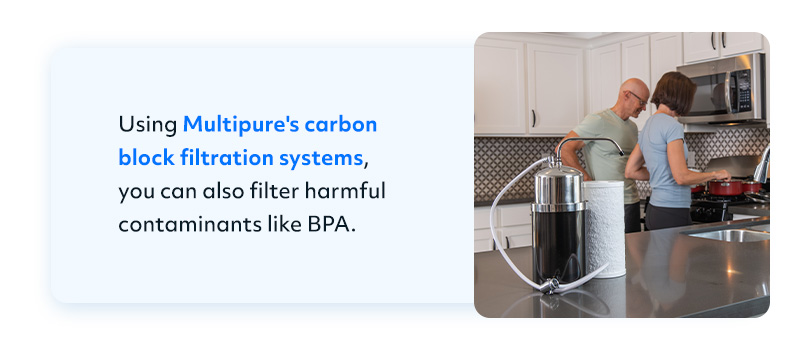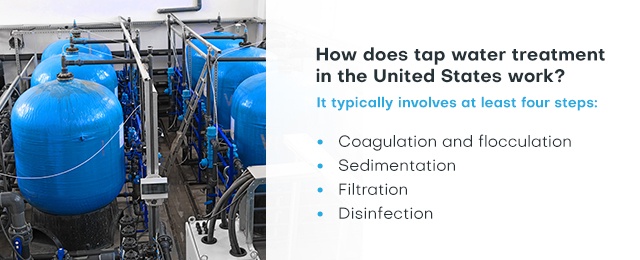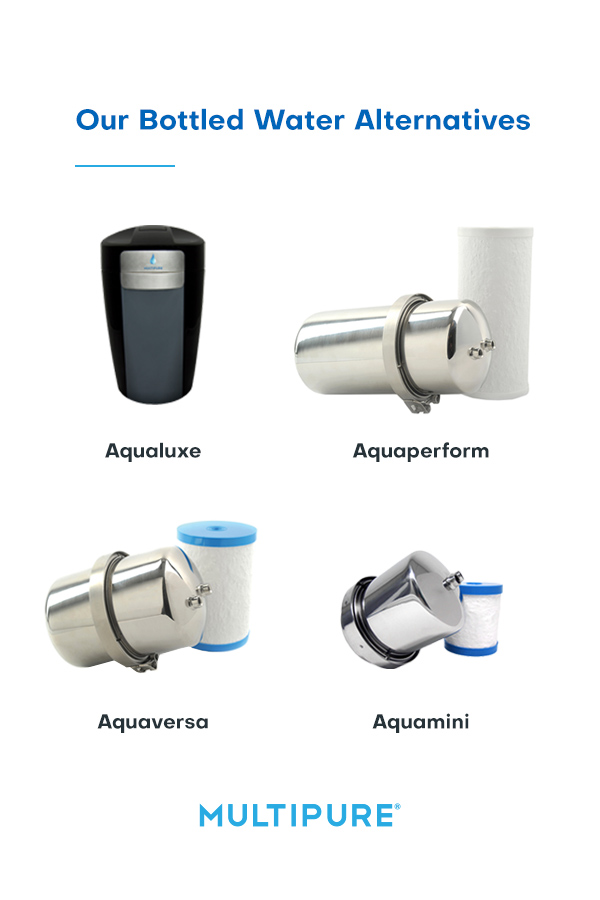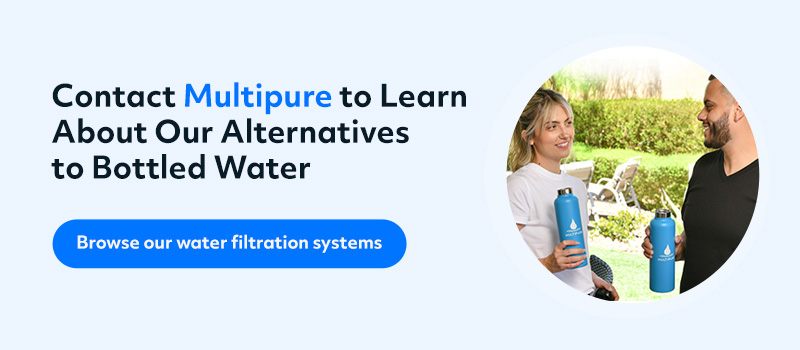The Harmful Effects of Plastic Water Bottles
Posted by Kenton Jones on Mar 21st 2024
Every year, Americans purchase bottled water by the millions. We tend to think of bottled water as better-tasting or healthier, but that's not always true. New research is uncovering previously unknown dangers posed by bottled water. Drinking tap water is often safer and better for the environment than purchasing bottled water from the store, and it's important to understand the risks of consuming plastic particles.
View Our Drinking Water Systems
Contents In This Post:
Why Do Plastic Water Bottles Pose Risks?
What Are the Health Implications of Using Plastic Water Bottles?
The Environmental Impact of Plastic Bottles
Healthy and Eco-Friendly Alternatives to Bottled Water
Contact Multipure To Learn About Our Alternatives to Bottled Water
Why Do Plastic Water Bottles Pose Risks?
Plastic water bottles pose health and environmental risks for many reasons. From harmful chemicals used to manufacture plastic to questionable treatments and fewer regulations for bottled water, here's why water bottles pose risks to humans:
Microplastics
Recently, researchers have found microplastics and arsenic in bottled water. As plastics gradually break down, they can form tiny particles known as microplastics and even smaller particles known as nanoplastics.
The National Institutes of Health (NIH) supported a 2024 Rutgers and Columbia University study on microplastics and nanoplastics. In this study, researchers used powerful imaging technology to detect plastics in water bottles from popular brands. With a special imaging technique, they concluded that each liter of bottled water contains approximately 240,000 nanoplastics and microplastics. This is a huge increase from a 2018 study that found 325 pieces of plastic per liter on average.
Unknown Water Source
When you buy bottled water, the source of the water may be unclear. Consumers often perceive bottled water as the cleanest form of potable water without knowing anything about its origins.
In the United States, bottled water typically comes in two varieties:
- Water from natural sources: Natural spring water, as its name suggests, comes from springs across the country. If the label on a bottle of water mentions spring water, the water usually does come from a natural spring or underground source. But sometimes, the marketing of naturally sourced water is misleading. Water called "Arctic Spring Water" may be from Florida, or water labeled "Glacier Mountain Natural Spring Water" may be from an underground source in New Jersey.
- Water from municipal sources: Bottled water labeled as purified water is often municipal tap water that has undergone filtration. Bottled water that has undergone treatment processes such as reverse osmosis, distillation, or other treatment methods may be marketed as purified water — but it's still your area's tap water, just rendered slightly cleaner with filters.
Chemical Hazards
Plastic water bottles contain chemicals, and those chemicals can leach into the water. This plastic leachate can have detrimental health effects on consumers. At certain levels of exposure, some of the chemicals in plastic, especially the chemical known as bisphenol A (BPA), have even been implicated as carcinogens. BPA is a synthetic estrogen often used to make polycarbonate plastics.
A recent study also found that bottled water can contain 10 to 100 times more plastic than previously estimated — nanoparticles so tiny that they can migrate through our digestive tract or lungs and into the bloodstream, potentially distributing harmful chemicals through the body.
Much of the research on BPA and its health effects has involved animal subjects, and more direct research on BPA and human health is necessary. However, because of the potentially disastrous health effects associated with BPA ingestion, many people prefer to avoid commercially bottled water by drinking tap water instead.
Questionable Treatments and Filtration Processes
Bottled water also poses risks due to questionable treatments and less government oversight to ensure its safety. While tap water is strictly regulated under the Safe Drinking Water Act of the Environmental Protection Agency (EPA), bottled water is regulated under the Food and Drug Administration (FDA), a completely separate federal agency.
Under the EPA's regulations, municipal water companies must ensure their water contains few contaminants and is safe for consumption. They test their tap water several times a day — up to 100 times or more per month.
In contrast, FDA regulations do not apply to bottled water unless it crosses state lines. That means bottled water made and sold within the same state — which comprises a lot of the bottled water we drink — receives very little oversight. Consumers cannot be sure the bottled water they purchased has received the right treatment to ensure its safety.Additionally, we've seen hundreds of bottled water recalls in the past few years due to contaminants like mold, glass and bacteria.
What Are the Health Implications of Using Plastic Water Bottles?
The chemicals and nanoplastics within disposable bottled water are linked to many health issues once ingested, ranging from hormonal disruptions to increased risk of cancer. Using plastic water bottles also poses bacterial health risks. Here's a deeper look at these health complications:
Physical Health Risks
As mentioned, the plastic in water bottles can be toxic to humans, posing health risks like inducing physical stress and damage, inflammation, and immune responses and leading to other issues. Here are some of the effects of BPA in water bottles:
- Disrupts hormones: BPA can block or mimic the action of the hormone estrogenand other sex hormones, and it disrupts the natural balance of hormones in the body. It can also disrupt the thyroid hormone system.
- Increased risk of cancer: Because estrogen can cause the development of certain types of breast cancer, BPA can do the same. That's why you see many reusable plastic water bottles marketing themselves proudly as BPA-free. However, many single-use plastic water bottles contain BPA.
- Negative effects on fetal development:BPA has also been implicated in negative effects on fetal development. Pregnant women who ingest high levels of BPA may have an increased risk of miscarriage, while infants can have a lower birth weight, develop obesity, or have issues with neurodevelopment or behavioral problems.
- Risks of phthalates:Phthalates, the chemical plasticizers added to plastics to increase their flexibility, are also suspect. Like BPA, phthalates in water bottles can disrupt the endocrine system, and they have a particular effect on male fertility. Research has also found potential links between these chemicals and diabetes, metabolic disruption, as well as adverse neurodevelopment in children.
Bacterial Health Risks
Bacterial contamination is a particular concern when reusing disposable plastic water bottles. Plastic water bottles are notoriously difficult to clean — their small crevices make it hard to get brushes, rags, or sponges into them.
Because they are challenging to clean, plastic bottles can easily become breeding grounds for bacteria. The moist environment allows microorganisms to flourish. If you drink from your water bottle while you're eating food, food residues can adhere to the bottle and promote further bacterial growth. Bacteria can impart an unpleasant taste or smell to your water, and it may cause gastrointestinal illness.
The Environmental Impact of Plastic Bottles
Every year, Americans throw away millions of water bottles. Discarded plastic water bottles harm the environment. Since plastic doesn't biodegrade well, the plastic bottles we throw away stay in our environment year after year.
Plastic bottles can take 450 years to decompose, so a plastic water bottle you throw away tomorrow could still be taking up space in the ground or floating in the ocean centuries from now. Here's a look at the impact of plastic pollution on wildlife and our overall environment:
Impact on Ecosystems
Plastic releases harmful chemicals into the environment as it breaks down. Plastic leachates like BPA and phthalates can seep into our soil, contaminating the groundwater we rely on for drinking, bathing, and washing food and cookware.
Reports have revealed 1.7 million tons of plastic make its way into the world's oceans. Marine animals can mistake plastic for food and eat it, causing them to get sick and die. Estimates reveal plastic pollution kills around 100,000 marine mammals each year, with 81 out of 123 species known to have eaten or become tangled in plastic. Some estimates also suggest that by 2050, the ocean will contain more plastic by weight than fish.
Plastic water bottles make up a significant share of this waste. By drinking tap water instead, you help cut down on plastic pollution — keeping marine ecosystems and wildlife healthy.
The Carbon Footprint of Production
Making plastic water bottles has contributed to significantly high carbon levels in our atmosphere. Every ton of plastic waste in landfills releases approximately 3 tons of carbon dioxide equivalentemissions.
Some of that carbon dioxide production occurs in transportation. Shipping plastic resins to manufacture water bottles and shipping the finished bottles generates carbon emissions by burning fuel.
A lot of the carbon dioxide production comes from manufacturing. Plastic manufacturing works by heating petroleum and natural gas to break down their large hydrocarbon molecules into smaller ones. By burning fossil fuels like this, we use up precious nonrenewable resources that account for an immense amount of the emissions associated with making plastic bottles.
Wasting Our Freshwater Resources
The issues associated with making plastic bottles don't end with pollution and carbon emissions. Making plastic water bottles consumes massive amounts of water as well.
Cooling heated plastic requires large volumes of water. The extrusion process involves feeding plastic through a long, heated chamber. The chamber's heat and its rotating screws melt the plastic, which flows through a small die to create the shape of the finished product. After the die extrudes the plastic, the plastic typically enters a water bath for cooling.
In most cases, it takes more water to make the plastic bottle than it will actually hold once ready for use.
Healthy and Eco-Friendly Alternatives to Bottled Water
Using a reusable water bottle made of stainless steel or other durable material is healthier, more cost-effective and better for the environment. You can get even more benefits if you add a filter to your sink.
Avoid Plastic Bottles
Reusing disposable plastic water bottles is not recommended. Since the bottles are intended for disposal, their plastic is thin and flexible, so they are likely to crack and break over time. You may end up injuring yourself or ingesting small plastic pieces if your bottle breaks after repeated use. The plastic may also begin to harbor bacteria.
There's also the issue of chemical leakage to consider. As you reuse a plastic water bottle, it may leak more chemicals into the water you drink. For health and safety reasons, it's better to use a cup, mug, or steel or BPA-free plastic water bottle.
Use a Home Filtration System
While tap water is often clean and safe, you can make it even fresher and healthier. Using a home water filtration system can reduce contaminants, giving tap water a refreshing taste we associate with bottled water — with much more reliable assurances about its safety. For instance, filtration can reduce chemicals like chlorine and chloramine found in tap water. These disinfectants give water an unpleasant taste and can affect your respiratory system and skin. However, filtration can reduce them in your water once they've done their job.

Using Multipure's carbon block filtration systems, you can also filter harmful contaminants like BPA. Say that plastic from a landfill has leached plastic chemicals into the groundwater, and the chemicals have entered the municipal water system. If the municipal filters, which often target older and better-known chemicals, don't filter them out, Multipure's state-of-the-art filtration systems can reduce these harmful contaminant levels. To make your tap water even healthier and cleaner, you can invest in one of Multipure's NSF certified home drinking water systems, including our go-to choice of the Aquapremier or one of our other systems:
- Aqualuxe: Multipure's Aqualuxe is our most advanced, high-performing drinking water system. This water purification system features the state-of-the-art PureBlock carbon block filter designed to remove microorganisms like viruses and bacteria and reduce a range of other contaminants such as forever chemicals, known formally as per- and polyfluoroalkyl substances (PFAS), and arsenic.
- Aquaperform: The Multipure Aquaperform uses our proprietary carbon block technology to filter various pollutants. It is NSF-certified for both contaminants that affect the taste and smell of your water and contaminants that pose health concerns. It sits discreetly under your cabinet or on your countertop to provide refreshing, healthy water. It's also certified for PFAS and arsenic reduction.
- Aquaversa: Multipure's Aquaversa is versatile — you can install it under your sink or as an extension of your kitchen faucet. It features our superior carbon block filtration technology to minimize a range of aesthetic contaminants and contaminants of health concern.
- Aquamini: The Multipure Aquamini is reliable and compact. It's the perfect choice for travelers, college students, or anyone who wants to improve water cleanliness while maximizing kitchen space.
Contact Multipure to Learn About Our Alternatives to Bottled Water
Now that you know some of the harmful effects of plastic water bottles, contact Multipure to learn about healthier options. Our drinking water systems' carbon block filtration technology reduces various harmful contaminants, including asbestos, BPA, cysts, chlorine, lead, mercury, pharmaceutical waste, pesticide residues, radon, and volatile organic compounds (VOCs). You'll gain peace of mind and excellent water with your filter.
Contact us today to learn more.




